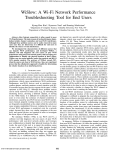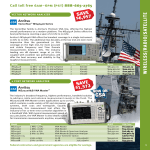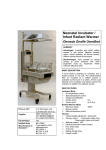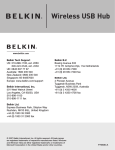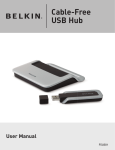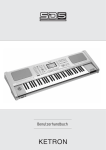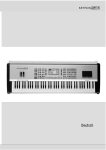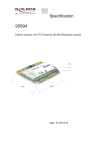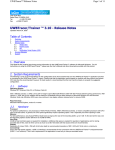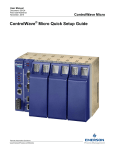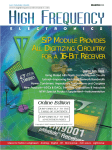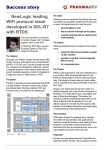Download incisor.tv
Transcript
INCISOR TM for the short range connectivity environment Issue 104 February 2007 CES, BEST BLUETOOTH, INCISOR TV BORN THIS ISSUE INCISOR TV / BLUETOOTH SIG BEST OF CES CSR CUTS BLUETOOTH HEADSET DESIGN COST CORONIS TAKES WAVENIS GLOBAL ICRON IMPLEMENTS 802.11 FOR USB HUB sponsored by 2 IMPORTANT - www.click.co.uk moves to www.incisor.tv from 3rd Feb 2007 incisor tv brand is born January was always going to be an important, and very busy month. Our travels to Las Vegas for CES and the two major video projects that we have completed for the Bluetooth Special Interest Group and for the WiMedia Alliance and member companies – Alereon, Artimi, Staccato Communications, Wipro NewLogic and WiQuest Communications – would have made sure of that. This issue, and the second, special issue that we publish shortly after, are the end result of several months very intensive activity. Both are video-enabled, and we hope that you enjoy this new direction we are taking. But there is another major development. Since Incisor publisher Click I.T. Ltd first established a presence on the Internet, our web-world has revolved around the www.click.co.uk domain name. However, for the last few years our company has been known to the world for Incisor magazine. For some time, we have considered re-branding to reflect this, but there has always been a new issue to publish, a show to go to – something always happening. Now, though, with our move to creating and publishing more rich media – that means video-enabled – content, we have decided the time is right. From the beginning of February we will switch to using the domain www.incisor.tv as the axis for our company. Our email addresses change too – simply substitute [email protected] for [email protected], for example. There will be a web site re-direction from the current home page www.click.co.uk, and email addresses will re-direct for considerably longer. So, Incisor continues, and Incisor TV is born. In fact, Incisor TV had its first official outing with the trip to Las Vegas. This is an exciting move for us. We hope you will continue to appreciate the work that we do. Vince Holton Publisher & editor-in-chief, Incisor BLUETOOTH EXCELLENCE ALSO THIS MONTH Incisor has had an excellent working relationship with the Bluetooth Special Interest Group for many years, and so we were pleased to work with the SIG again in Las Vegas, Incisor TV being given the opportunity to cover this year’s Best of CES contest. INCISOR GOES TO CES This gave us the chance to see a collection of the most innovative Bluetooth products of the year. On the following page there is the opportunity for all Incisor readers, including those who couldn’t make it to CES, to see these products, and to get a flavour of the world’s largest consumer Electronics show. Includes Bluetooth SIG ‘Best of CES’ video presentation NEW BLUETOOTH HEADSET DESIGN SPORTS $6 BUILD COST CSR launches a new Bluetooth chip and reference design CORONIS TAKES WAVENIS TECHNOLOGY ONTO GLOBAL MARKET Ultra low power, range, robust performance – Wavenis from Coronis has it all, plus 1 million installed devices EDITORIAL CONTACTS PRODUCED/DISTRIBUTED BY: www.click.co.uk – NOW – www.incisor.tv Hampshire Gate, Langley, Rake Hampshire GU33 7JR, England Tel: +44 (0)1730 895614 Incisor provides commercial and promotional opportunities. Sponsorship and advertising enquiries should be directed to Vince Holton CONTACT DETAILS: Editor-in-chief: Vince Holton · [email protected] Telephone: +44 (0)1730 895614 Contributing writers: Rebecca Russell, Manek Dubash, Paul Rasmussen, Mads Oelholm. Publisher/Editor-in-chief: Vince Holton · [email protected] – NOW – [email protected] Telephone: +44 (0)1730 895614 Contributing writers: Rebecca Russell, Manek Dubash, Paul Rasmussen, Mads Oelholm. Views expressed within are those of the Incisor editorial and management representatives, and of the representatives of sponsor companies. Incisor is distributed on a monthly basis to companies and individuals with an interest in short range wireless technology. Subscribe to Incisor free of charge at: http://www.click-incisor.com/subscribe.php Should you wish to stop receiving Incisor, please send a message titled 'UNSUBSCRIBE to: mailto:[email protected] – NOW – mailto:[email protected] The Bluetooth word mark and logo are registered trademarks and are owned by the Bluetooth SIG, Inc. Incisor and the Incisor brandmark are trademarks of Click I.T. Ltd. All other logos and trademarks are the property of the relevant companies. © Copyright Click I.T. Ltd 2007 3 IMPORTANT - www.click.co.uk moves to www.incisor.tv from 3rd Feb 2007 Incisor TV goes to CES solutions such as WiMAX (also known as 4G) that were grabbing most of the attention. What about PCs? Well, handheld PCs are getting smaller and slimmer, and some of them even make a half-decent fist at working usefully. Sony’s Vaio UX50 is truly tiny – about the size of your fist, and yet it offers full laptop speed. VoIP was another strong flavour. An increasing number of handheld devices now have Internet calling capability on board as standard. So what was CES like? We have to admit that is a little difficult to answer for your Incisor columnists as we spent most of our time working on filming projects for Incisor TV. You can see one of the results of this work further down this page when you view the video presentation we have made for the Bluetooth Special Interest Group. Incisor TV covered the SIG’s best of CES award programme. If you want to see some of the most exciting Bluetooth products at CES, including the Motorola product judged by the SIG executives to be the most outstanding Bluetooth product at CES 2007, check out the video now. gadgets to sell to the millions who already own HD-ready screens. So, in the limited time we had touring the show, what impressions did we come away with? It must be said that the dominant technology at the show was TV – and endless HDTV flat panels in particular. High definition flatscreens have sold millions, and made billions in the past year, and so it was inevitable that the thousands of companies occupying CES’ 1.8 million square feet of exhibition space would be focussing on Moving content If a consumer wants to be able to watch his HD TV content in more than one place, and to move that content around, he will want to do it as simply as possible. That means wireless technology. Although the Wi-Fi companies are scrambling to promote 802.11n as video streaming technology, it felt like it was technologies such as UWB/Wireless USB and longer-range And if you thought you were getting to grips with HD TV, you know the difference between 720p, 1080i and 1080p, and you feel that you have safeguarded your investment by buying a flat panel TV with some element of future-proofing, then get ready to be disappointed. Quad HD is just around the corner, boasting a brain-sapping 8,840 x 2,160 resolution display. Trailblazer developer Westinghouse had to demo Quad HD using scientific data, as no Quad HD content is available! Bluetooth SIG Best of CES 2007 Incisor TV covers the second annual Bluetooth Special Interest Group’s Best of CES contest. Bluetooth SIG executive director Mike Foley provides an insight into what makes an outstanding product, announces the winners in the Mobile Phone, Headset, Audio, Printing and Imaging and Human Interface Device categories, and then awards the top prize to this year’s winner. CLICK THE SCREEN OPPOSITE TO WATCH THIS PRESENTATION. Handset developments Where does this leave the conventional handset? Getting smarter, is where. Smartphones are becoming smaller, smarter and more desirable. Asian companies such as Samsung and LG continue to chip away at the Motorolas and Nokias at the top of the market. Samsung’s Blackberry-alike, the Blackjack winning the Handset category in the Bluetooth SIG’s Best of CES contest (and hats off to the Samsung marketing team for that stunningly originally name). By contrast, Nokia and Sony Ericsson’s ranges are looking a little old-fashioned. Apple had tried to pull the rug on the major handset vendors by announcing its much-anticipated iPhone away from CES, pulling back the screens in San Francisco as CES opened. Doubtless the black polo neck/design community will buy the iPhone regardless of what it costs, but it remains to be seen whether it has the impact on the handset market that Steve Jobs predicted. And the one other technology that had increased its share of CES real estate was GPS, which was not surprising because it has gained a lot of traction during 2006. One clever new application was the integration of the GPS display with the display used for vehicle backup cameras (mounted on the rear of the vehicle so you can see while backing up). Interestingly, the link from the camera to the display was yet another Bluetooth chip! 4 IMPORTANT - www.click.co.uk moves to www.incisor.tv from 3rd Feb 2007 news Chancing lawyers mount Bluetooth patent infringement bid As 2006 came to an end, and just as most of the US and European technology industry was winding down for the Christmas break – or preparing for CES, more likely – an aggressive legal worm came out of the Bluetooth woodwork. On Dec 21st in the U.S. District Court for the Western district of Washington, a Washington state organisation - the Washington Research Foundation (WRF) – filed a suit against Nokia, Samsung, Panasonic of North America and Matsushita for making and selling Bluetooth products that, it claims, infringe on at least one patent. The WRF is a non-profit organisation that claims to help Washington state universities and research institutes commercialise technologies and also helps fund research at such organisations. This is not the first such legal action that WRF has brought, and some see WRF as making its living off such cases (see below). Incisor understands that the patents can be traced back to Ed Suominen, a student who was studying radio design at the University of Washington before receiving a bachelor's degree in electrical engineering in 1995. The WRF claims that at least one of the patents, related to radio frequency receivers, is used in the Bluetooth standard. Now, that patent was filed in August 2003 and granted on Oct 3rd 2006. Long term Incisor readers will know that the first version of the Bluetooth specification was approved in 1998 and has passed through several updates since, creating new versions of the spec. This action apparently came as something of a surprise not only to the companies sued, but also to the Bluetooth Special Interest Group (SIG). Quoted at the time, marketing director Anders Edlund commented: “The more than 6,000 companies that belong to the Bluetooth SIG agree to license their relevant patents to other members without cost. It seems to have worked so far so this lawsuit was kind of a surprise.” Edlund also suggested that the SIG has also done legal investigations to ensure that companies can build Bluetooth products without infringing on patents. An official statement said “The Bluetooth Special Interest Group (SIG) has been asked this week about a lawsuit filed by the Washington Research Foundation that questions several patents allegedly related to Bluetooth technology. The SIG is not involved in the lawsuit and is not named as a party. At this time, our legal staff is reviewing the lawsuit and we will comment further if appropriate.” Indirectly, the suit is addressed at CSR, which supplies Nokia and the other defendants. CSR’s most serious contender in the Bluetooth market – Broadcom licenses patents from WRF, whereas CSR doesn't, the WRF said. The WRF has asked the US court to forbid the companies from importing or selling the relevant Bluetooth products in the U.S. and is also asking for damages for historical infringement. Asked why the WRF had not tried to sue CSR, WRF attorney Steven Lisa explained that his organization decided to act against the handset makers because the chipset manufacturer may not know which chips are headed to the United States, where the patent is enforceable, but the device-maker would. Lisa commented: "You can find a way to use Bluetooth that doesn't infringe on the patents, or you can buy it from Broadcom. That's why WRF is not going to sit back and let it go without it being addressed.” CSR seems unruffled. In an early statement following news of the court case, it said: “CSR has taken advice from its attorneys. The suit is without merit in relation to CSR's Bluetooth chips and CSR will defend its products vigorously" In the couple of weeks that have followed the original statement, CSR has maintained this position. Others have been forthright in dismissing WRF’s actions. One industry luminary, who – understandably while the legal arrows are flying – wished to remain un-named, commented: “This firm (WRF) is well-known as a business that makes its money out of aggressively launching patent-infringment lawsuits. This is just the latest such action and will probably be dismissed.” Other commentators have tarred WRF with the same brush, confirming the widely-held belief that WRF’s business model is based on making money from lawsuits, and there was also suggestion that there was almost certainly an anti-competitive element to this story, with Broadcom set to benefit from any net effect on CSR. Whilst not straying into these waters, Stefan Svedberg, a Bluetooth SIG board member and Ericsson executive went on record, saying “These types of lawsuits, launched by companies that claim they have technology essential to existing standards, aren't completely uncommon. The set up of the Bluetooth SIG is something that would minimise this risk but it's not a surprise that there might be some parties like this out there.” As Incisor went to press, approaching a month after the original announcement of WRF’s lawsuit, we made attempts to learn of any new developments. And you know, there weren’t any. Everything has gone very quiet, and the newswires have stopped buzzing. Perhaps this simply means that the legal machine is quietly rolling along, and it will be a while before we hear anything else. Or, just perhaps, the initial sabre-rattling has not promoted the knee-jerk, submissive reaction that WRF hoped for, and this matter will simply fade away. With any glimmer of a pay-out, lawyers tend to be tenacious, so we doubt it is the latter. However, we believe that it is highly unlikely that this action will dent CSR or Bluetooth as a whole. We will follow up in the next issue if there is anything further to write about. 5 IMPORTANT - www.click.co.uk moves to www.incisor.tv from 3rd Feb 2007 news CSR acquires NordNav Technologies and Cambridge Positioning Systems - will deliver sub $1 GPS CSR has acquired the entire issued share capital of NordNav Technologies AB and the assets of Cambridge Positioning Systems Ltd. CSR plans to provide software-based high performance GPS (Global Positioning System) suitable for mass-market mobile handsets, PNDs (Personal Navigation Devices), PCs and other portable devices for an incremental price that falls to less than $1 of the overall bill of materials when used with CSR’s Bluetooth. NordNav, based in Sweden, has been acquired for an initial cash consideration of $40 million. A further cash consideration of up to $35 million may be payable subject to future performance objectives being met by NordNav. CPS, based in Cambridge, UK, has been acquired for a total cash consideration of $35 million. Both NordNav and CPS were private companies, principally owned by venture capital. The acquisitions will both be financed entirely from CSR’s existing cash resources. CSR expects to offer its first GPS products during the first half of 2007, and anticipates both acquisitions will be earnings enhancing in 2008. CSR says that the acquisitions are a further step in CSR’s strategy of diversification which already includes WiFi, FM, UWB (Ultra-Wide Bluetooth) and WiBree. As well as bringing a new product offering, CSR acquires significant additional research and development engineering talent. In total, over 40 employees have transferred to CSR from NordNav and CPS. John Scarisbrick, CEO of CSR commented: “We are delighted with these acquisitions. We will be able to provide a technically superior GPS solution which at less than $1, allows GPS to be affordable to all. CSR’s customers are enthusiastic for GPS at this much lower price point and I am confident that we will see a significant increase in mobile handset attach rates for GPS and location based services. Our focus remains on the handset market and we are executing on our strategy to add value beyond Bluetooth in the phone. We will continue to invest both organically and via complementary acquisitions to further improve our product offering, enhance our customer proposition and maintain our competitive advantage.” AvantWave Bluetooth module has CSR inside AvantWave is shipping a Bluetooth v2.0 + EDR (Enhanced Data Rate) module that uses CSR’s BlueCore4-ROM silicon. The Bluetron BTR300S Bluetooth SiP (Systemin-Package) is integrated with a multi-layer antenna. The module has apparently been particularly embraced by designers of newgeneration MP3 devices wishing to add value to their products through wireless streaming of music and data transfer. Jon Hudson, SVP of CSR’s Consumer strategic business unit said, “The BTR300S is a prime example of CSR’s extensive partner support. The success of this module within the MP3 market shows that we have achieved this objective and we expect to announce the first end designwins in the coming months.” Jonathan Lee, CEO for AvantWave commented, "The new BTR300S module offers device manufacturers the most complete Bluetooth solution. CSR’s technology and support is vital to providing our customers with the most advanced Bluetooth on the market and overcoming time, cost, and design constraints.” GN/Jabra re-brands, shows new products at CES GN, known to most Incisor readers for its Jabra Bluetooth and office headsets, used CES as the vehicle to promote a company re-branding exercise. GN will brand all of its products as Jabra from now on. Previously it had used its GN Netcom brand for products aimed at enterprises and offices and the Jabra brand for consumer products. All new products will carry the Jabra brand and existing products will migrate to the Jabra brand over the next 12-15 months. The process started immediately with the multimedia series and the re-branding of the recently launched GN 500 which became the Jabra GN5000. “Over the last few years, the Bluetooth headset market has grown exponentially and if forecasts are accurate we expect to see market growth of 74% from 58 million units in 2006 to 222 million units in 2011. If we are to capitalise on that opportunity, though, we need to make sure we’re well positioned,” said Toon Bouten, President and CEO of GN Store Nord. “Our communications will now all fall under the Jabra brand and we will use its power to support our already-strong position in the enterprise and contact centre segment as well as underpin our ambitious goals in the mobile category. We see a very clear direction for the headset market and that is towards convergence. Office headsets, IP telephony, headsets for mobile users and those for entertainment devices are all beginning to merge and we need to be at the vanguard of this change if we are to maintain our leadership position.” The ‘new’ Jabra was unveiled at the Jabra booth at CES, which also marked the announcement of a number of new products, including Jabra’s first Bluetooth hub, the A7010, which enables its JX10 mobile headset to work with desk phones. The A7010 becomes available in Q2. 6 IMPORTANT - www.click.co.uk moves to www.incisor.tv from 3rd Feb 2007 news Innovision shows Smart Poster and ‘tag in a box’ NFC at CES RFI expands cellular handset testing capability in Korea The hockey stick arrives for wireless data apps British firm, Innovision Research & Technology, which is developing NFC solutions, used the popularity of CES to demonstrate NFC working demos, including the so-called Smart Poster. RFI Global Services (RFI), has installed a specially commissioned Radiated Spurious Emissions chamber at its test facility in South Korea, which was opened in June last year. Requiring an investment of £500k the fully automated Radiated Spurious Emissions (RSE) measurement chamber will provide accredited RSE measurements on cellular devices defined within TS51.010-1 and EN301908-1. Proponents of wireless data have been predicting that there will be a sudden growth of wireless data applications, creating a "hockey stick"-shaped revenue forecast starting two years out every year for the past 20 years. These predictions have finally come true, according to market researcher In-Stat. In a recent survey, In-Stat found that 78% of all organizations have at least one wireless data application. This is up from 65% in 2005 and under 1% a decade ago. Organizations typically start with desktop applications and virtual private networks (VPNs). Once proven, they move to more sophisticated applications. A significant majority of the respondents said that they are planning additional applications. Larger organizations tend to plan to add applications that more closely integrate their field workers into the daily workflow. For example, they are adding Enterprise Resource Planning (ERP) and Sales Force Automation (SFA) applications. Most of these applications are on wirelessenabled laptops. However, the next most popular device is the smartphone. Smartphones will become increasingly important as wireless data applications increase their reach. The applications drive usage on the data networks of wireless carriers. Wireless Data is a significant component of the increased Average Revenue Per User (ARPU) that carriers are starting to see. If these plans follow historic growth patterns, data will be an increasingly large part of carrier ARPU. From the user side, not all of this growth is being properly managed. About half of all organizations leave the decision to the enduser as to which wireless carrier and service plan to pick. This is in spite of the fact that most organizations that track the wireless data budget find that they are spending the same or more on wireless data than on wireless voice services. According to Innovision’s business development director, Marc Borrett, the Smart Poster application brings NFC to life. “Touch is the new click. Its beauty lies in its simplicity and flexibility – by integrating an NFC tag into an everyday object, like a bus-stop timetable for example, individuals can simply touch their NFC-enabled device, such as a mobile phone, against the tag and receive the latest bus times for their chosen destination. This demonstrates the specificity of NFC – specific information, where you need it, when you need it.” Innovision demonstrated its ‘tag in a box’ application with an NFC-enabled mobile phone and a range of NFC tags, showing multiple user benefits, but without significantly higher costs. At the application level the first tag will be preprogrammed with the user manual; the second with partner information (such as a ring tone or wallpaper). The third tag will be programmable, allowing the user to programme the tag themselves with their own phone number or other personal information. The company also launched Topaz, one of only three proprietary tag types to be mandated by the NFC Forum, this year. According to Marc Borrett, “straightforward applications like the Smart Poster and ‘tag in box’ are likely to be popular with visitors to the Innovision booth, because they really highlight the simplicity and relevance of this exciting technology. The opportunities are endless”. The RSE facility involved the collaboration of a number of suppliers and took 3 months to complete. It includes a Rainford fully lined anechoic chamber with Orbit DUT positioning system and a Rohde and Schwarz TS9976 measurement system. The chamber is fully accredited by UKAS for 2G and 3G handset testing and is unique in that it is the only facility to include a 3D positioner system. To date RFI’s investment in its Korean facility exceeds £4m. The growth in cellular terminal manufacturing and development in East Asia is such that 60% of RFI’s cellular testing demand now comes from Korea, Taiwan, Japan and China. As part of the test and compliance process, Manufacturers must test for and certify that the output spectrum of their products meets the relevant criteria as to radiated levels for all spurious emissions. RFI tells Incisor it is currently the only company able to provide full 2G and 3G approvals worldwide, and supplies environmental, regulatory and compliance services to the wireless, cellular, smartcard, electronics and related technology industries around the world. With 1,000,000 devices deployed, Wavenis clearly offers integrators the wireless connectivity they need: long-range connections and ultra-low-power consumption for hard-to-reach devices. Designed with highly sought-after Bluetooth extension capabilities, Wavenis complements other wireless technologies. Join the innovators who can tell the difference between hype and performance! ©B-toB Design in Montpellier - France Wavenis is now the standard for 1,000,000 long-range and ultra-low-power wireless devices. 8 IMPORTANT - www.click.co.uk moves to www.incisor.tv from 3rd Feb news CSR brings BT v2.0 to austriamicrosystems' MP3 platform CSR's BlueCore Bluetooth technology has been selected by austriamicrosystems for its new Mobile Entertainment platform. The AS3525 and AS3527 core devices of the platform are both high performance singlechip-systems targeting enhanced MP3 players with multimedia aimed at the OEM market. austriamicrosystems' ARM9 SoC in the AS3525 and AS3527 delivers over 200MIPS of processing power and allows the implementation of an MP3 player with only 50mW total power consumption. It delivers video playback to LCD and OLED screens at up to 30 frames per second (fps) and up to QCIF+ resolution, while streaming audio via its independent Bluetooth headphone and line outputs. Its system firmware is Microsoft PlaysForSure V2.0 compliant and supports MP3, WMA, AAC and OGG audio, JPEG, GIF and BMP photos as well as MPEG4 and Microsoft WMV Mobile Video contents. The platform has been tested by the National Software Testing Lab (NSTL) to be interoperable with Windows Media Player 11 and with Windows Vista. The AS3525 and AS3527 reference design features CSR's BlueCore4-ROM, single-chip radio and Bluetooth baseband IC, which CSR has designed to reduce the number of external components required in order to minimise the overall bill of materials (BOM). In addition, BlueCore4 technology incorporates auto-calibration and built-in self-test (BIST) routines to simplify development, type approval and production tests. Personal Media Players (PMPs) designed around austriamicrosystems' reference designs will therefore be compatible with all other Bluetooth devices thanks to BlueCore4-ROM backward compatibility with existing Bluetooth v1.1 and v1.2 specifications. austriamicrosystems has also ported CSR's BlueCore Host Software (BCHS) onto its host ARM9 processor to run A2DP and AVRCP profiles. These profiles enable consumers to listen wirelessly to their music on Bluetooth stereo headphones and through Bluetooth enabled home media entertainment systems. Tracy Hopkins, VP, Consumer Strategic Business Unit at CSR commented, "As device manufacturers are looking to integrate more functionality into MP3 players and PMPs, the desire for integrated Bluetooth connectivity has increased. Consumers increasingly want to share music and the ability to stream the same audio track to two Bluetooth headsets from a single player is very desirable thus negating the need to share headphones." austriamicrosystems' Mobile Entertainment platform was shown and demo’d at CES. Jennic commits to Korea market Jennic Ltd has today opened a branch office in Seoul, Korea, and appointed Mr. SY Youm as sales manager to spearhead in-country support and field sales. Jennic is headquartered in the UK and had established branch offices in Japan, Taiwan and the USA. Mike Clancy, Jennic's senior vice-president of worldwide sales, commented, "Korea has taken a leadership position for automation and efficiency with the Government's IT839 strategic vision for the Korean IT industry. There are at least two areas of IT839 where Jennic's wireless microcontroller technology provides an ideal solution: the u-Home and u-Sensor Network. Jennic's wireless microcontroller has a software architecture which is ideal for simple/propriety IEEE802.15.4 network solutions or a standards' based network solution like ZigBee. The Korea branch office will be strategic to Jennic's continued growth, not only within the region, but globally." PROX technology now available on BlueCore CSR has announced what it describes as an important third-party software enhancement for its BlueCore Multimedia platform. Via its eXtension Partner Programme, CSR's BlueCore Multimedia platform now offers STEP's suite of audio acoustic technologies for high performance headsets and hands-free car kits. PROX, one of STEP's core technologies and aimed at dual microphone headsets, was introduced at CES. PROX technology brings improved noise reduction to the BlueCore Multimedia platform while maintaining the purity of the speaker's voice. STEP's acoustics and DSP algorithms take advantage of BlueCore Multimedia's onchip Kalimba DSP to offer a complete highend Bluetooth headset solution. "Using the physics of sound wave propagation, PROX technology is able to extract clear voice signals from environments with greater than 80 db background noise. The addition of STEP's technology to the BlueCore Multimedia platform will significantly increase the quality of wireless voice communication, creating an enhanced user experience" said Robert F. Mitro, Chairman and CEO, STEP Communications. "The introduction of PROX technology to CSR's BlueCore Multimedia platform offers headset designers an easily integrated package for designing very high customer satisfaction Bluetooth-enabled headsets." "CSR's integrated DSP is the only complete Bluetooth silicon solution on the market that offers PROX technology the perfect environment to take advantage of STEP's advanced DSP algorithms," Anthony Murray, SVP of CSR's Wireless Audio strategic business unit commented. "Due to support of third party software vendors, CSR's relationship with STEP has introduced an enhanced level of voice communication for Bluetooth headsets." 9 IMPORTANT - www.click.co.uk moves to www.incisor.tv from 3rd Feb 2007 new products Parrot expands Bluetooth range at CES pickup and a 5-watt speaker allows conversations in normal voice levels for all participants. French company Parrot is carving a niche for itself as a developer of Bluetoothenabled devices. Having first come to Incisor’s attention with a range of automotive Bluetooth products – OEM and aftermarket car kits and speakerphones - it is now introducing a range of Bluetoothenabled consumer electronics products. Two of these were on show at CES. Because it is wireless and powered by three rechargeable Lithium Ion batteries, the speakerphone can be moved from office to conference room to accommodate phone meetings wherever they occur. The batteries provide 10 hours of continuous talk-time, and fully recharge in five hours. And the Parrot Conference can be paired with up to 50 phones. First we saw a digital photo frame Called the Parrot Photo Viewer 7”,that holds more than 500 images and has a seven-inch active-matrix TFT screen.. Photos can be transferred to the Parrot Photo Viewer 7” from a Bluetooth-enabled cell phone, digital camera, laptop or other storage device and will display them in slide show or freeze-frame mode. Built-in sensors keep the image upright whether the frame is positioned vertically or horizontally. The viewer also allows for brightness adjustment and shuts off automatically when it’s dark. The frame uses Bluetooth version v2.0 + EDR. Size-wise, it measures 8.75 x 7 x 1 inches, and weighs 17 ounces. It will be available online and through retailers in the U.S. in the second quarter of 2007 with an MSRP of $249. … and Bluetooth Conference speakerphone Parrot also showed how Bluetooth can bring convenience to corporate boardrooms, offices and conference rooms with the launch of a Bluetooth wireless speakerphone. Called the Parrot Conference, the speakerphone features Parrot’s proprietary digital signal processing technology with full duplexing for echo-free conversations in both small and large rooms. Its three microphones provide 360-degree voice With VoIP in mind, Parrot has fully integrated Internet communications (VoIP) software, and, for Skype subscribers, the Parrot Conference comes with an integrated Skype interface so it is ready to use out of the box. Up to 6,000 contacts can be loaded wirelessly via Bluetooth-enabled cell phones, PDAs, and laptops. Conference calls can be set up hands-free with voice activated controls, and a built-in digital keypad also allows manual dialling if required. Jabra adds lightness Jabra has announced a new, light-weight headset – the Jabra BT125 – which, at just 14g, is claimed to be among the lightest and most compact in its category. The BT125 features Jabra’s Over-the-Ear wearing style and is a Bluetooth 2.0 device, supporting the headset and hands-free profiles. “At just 14 grams, our new model really does mean users can put on their headset and forget it’s even there allowing them to enjoy the pleasure and convenience of hands-free mobile communication,” said Jabra spokesman Andrew Doyle. “What’s more, with features such as one-touch voice dialling, the Jabra BT125 is easy and intuitive to use.” Features of the Jabra BT125 include a standard answer/end call button and volume control, both located on the headset so users don’t need to touch their mobile phones when answering calls and adjusting volumes. By using the enhanced functionality offered by the hands-free profile, users can voice-activate mobile phone calls and use last number redial. Incisor is not quite sure how they do this, as instant pairing is an asyet ‘wish list’ feature, but Jabra claims that the headset can be paired instantly with a Bluetooth enabled mobile phone and supports Bluetooth 2.0. The Jabra BT125 offers up to 8 hours talk time and up to 170 hours standby time. It is available now and carries a recommended retail price of £29.99. New handheld spectrum analyzer from Anritsu Test equipment company Anritsu has introduced the MS2724B, a spectrum analyzer offering continuous frequency coverage from 9 kHz to 20 GHz. Anritsu has also introduces the MS2721B and MS2723B handheld spectrum analyzers which offer frequency coverage up to 7.1 GHz and 13 GHz, respectively. These are aimed at engineers and field technicians designing, deploying, and optimizing the performance of wireless devices and networks ranging from commercial to defence and public safety. These three models are the first in the Anritsu’s Spectrum Master family to feature a quasi-peak detector and CISPR bandwidths for EMC pre-compliance testing. RBW range of these units is 1 Hz to 3 MHz, as well. Additionally, the MS2721B can be equipped with a tracking generator that provides calibrated output from 400 kHz to 7.1 GHz with a power range of 0 to -40 dBm in 0.1 dB steps. Designed for the field, the MS272xB Spectrum Master models provide more than two hours of battery life. They can also be recharged using the lighter connection in a truck. 10 IMPORTANT - www.click.co.uk moves to www.incisor.tv from 3rd Feb 2007 New Bluetooth headset design sports $6 build cost by Luke d’Arcy, CSR connector for charging – onto a PCB that measures just 1.7 x 4.2cm. The board features a rounded end that helps it to fit into both clip and ear-hanger style designs. The design is fully tested and qualified for interoperability, and offers a number of configurable features, including the functionality of button presses, LED flashing, and pairing operation. A Windowsbased configuration tool is included as part of the package, enabling developers to configure their own HMI schemes very easily. Behind this tool is a powerful new iteration of CSR's established headset software, Headset v4, which is already used by a large number of Bluetooth phones on the market. The software supports Bluetooth 2.0 + EDR, eSCO, and the Hands-Free 1.5 Profile. In a move that is set to expand the market for Bluetooth headsets significantly, CSR has launched a new Bluetooth chip and reference design which dramatically lowers OEMs’ production costs. The total estimated bill of materials (BOM) is just $6 – and this includes the chip, PCB, lithiumion battery, microphone, speaker and the few additional components that are needed to create a complete Bluetooth headset! The new chip, known as BlueVox-QFN, features a very high receiver sensitivity of 88dBm, some 3dBm up on the previous iteration, which can pick up even the faintest of signals with crystal clarity. Not that faint signals are ever likely to be a problem – the chip’s transmitter stage has an output power of +6dBm. The RF performance of the new chip makes it ideal for link-sensitive applications such as a handset working in a briefcase or the boot of a car, which up until now have demanded some form of external RF power amplifier to ensure satisfactory operation. CSR has also kept the power consumption of the new BlueVox-QFN chip to an all-time low; it boasts a battery life of up to 11 hours from a 90mAh cell. A number of techniques are employed to achieve this world-class figure. The chip features multiple independent power domains, each of which is powered-up only for the time that it takes to complete its function; it also implements the latest version of the Bluetooth specification, using EDR (enhanced data rate) to minimise transmission time and conserve energy. The BlueVox-QFN chip has its own built-in high efficiency switch-mode power supply and battery charger circuits, which accommodate both lithium-ion and lower cost nickel-metal hydride cells. As its name implies, the BlueVox-QFN chip is housed in a flat 48-pin quad, no-lead package; the previous version, BlueCore4ROM, was packaged as an 84-ball VFBGA. The new QFN package employs a simpler silicon interconnect structure, which improves RF performance, and only requires a single-sided dual-layer PCB, helping to further reduce OEMs’ manufacturing costs. CSR’s reference design packs everything that is required for the headset electronics – including microphone, speaker, battery, antenna, buttons, LEDs, and mini USB Other features include support for the onchip wind noise reduction filter, customerspecific ringtones, 3-way calling, sidetone generation and auto reconnect after linkloss and power-down. This broad functionality enables designers to implement a low-cost headset without compromising audio quality or user experience. The wind noise reduction filter, for example, supports use even in noisy environments, and the addition of sidetone gives a more natural user experience by feeding back a small amount of the user's voice into the speaker. BlueVox-QFN is set to open up new markets for low-cost, high voice quality mono Bluetooth headsets. The chip and reference design are available now, and the first headsets using the new technology are expected to appear on the market within three months. Luke d’Arcy is the Product Marketing Manager in CSR’s Wireless Audio Business Unit. He can be reached via luke.d'[email protected] sponsored contribution incisor.tv www.incisor.tv · www.incisor.tv · www.incisor.tv · www .incisor.tv · www.incisor.tv · www.incisor.tv · www.incis · www.incisor.tv · www.incisor.tv · www.incisor.tv · w w.incisor.tv · www.incisor.tv · www.incisor.tv · www.inc www.incisor.tv · www.incisor.tv · www.incisor.tv · www .incisor.tv · www.incisor.tv · www.incisor.tv · www.incis · www.incisor.tv · www.incisor.tv · www.incisor.tv · w w.incisor.tv · www.incisor.tv · www.incisor.tv · www.inc www.incisor.tv · www.incisor.tv · www.incisor.tv · www .incisor.tv · www.incisor.tv · www.incisor.tv · www.incis · www.incisor.tv · www.incisor.tv · www.incisor.tv · w w.incisor.tv · www.incisor.tv · www.incisor.tv · www.inc www.incisor.tv · www.incisor.tv · www.incisor.tv · www .incisor.tv · www.incisor.tv · www.incisor.tv · www.incis · www.incisor.tv · www.incisor.tv · www.incisor.tv · w w.incisor.tv · www.incisor.tv · www.incisor.tv · www.inc www.incisor.tv · www.incisor.tv · www.incisor.tv · www .incisor.tv · www.incisor.tv · www.incisor.tv · www.incis · www.incisor.tv · www.incisor.tv · www.incisor.tv · w w.incisor.tv · www.incisor.tv · www.incisor.tv · www.inc www.incisor.tv · www.incisor.tv · www.incisor.tv · www .incisor.tv · www.incisor.tv · www.incisor.tv · www.incis · www.incisor.tv · www.incisor.tv · www.incisor.tv · w w.incisor.tv · www.incisor.tv · www.incisor.tv · www.inc www.incisor.tv · www.incisor.tv · www.incisor.tv · www .incisor.tv · www.incisor.tv · www.incisor.tv · www.incis · www.incisor.tv · www.incisor.tv · www.incisor.tv · w w.incisor.tv · www.incisor.tv · www.incisor.tv · www.inc www.incisor.tv · www.incisor.tv · www.incisor.tv · www .incisor.tv All· email www.incisor.tv · www.incisor.tv · www.incis addresses use the same prefix (e.g. ‘name@’ or ‘info@’) to the new suffix ‘@incisor.tv’ · www.incisor.tvand· change www.incisor.tv · www.incisor.tv · w w.incisor.tv · www.incisor.tv · www.incisor.tv · www.inc www.incisor.tv · www.incisor.tv · www.incisor.tv · www Remember... From February 2007, www.click.co.uk moves to... www.incisor.tv 12 IMPORTANT - www.click.co.uk moves to www.incisor.tv from 3rd Feb 2007 Coronis takes Wavenis technology onto global market Clever ideas can come from small, medium and large companies. Large companies have the resources to let the world know about their clever ideas, and the innovative products that result. Those large companies also have the influence to persuade people to work with them and to adopt their good ideas – easing the growth of that clever idea into a standard that others support. Most often, this is how standards are born, and specifications created. But there is one other way that a company can take a good idea and turn it into a globally recognised standard, and which doesn’t need the company to be a global giant. That is by building products that sell in large numbers to customers. Those sales will come because the product or technology meets a need, reliably does the job it is supposed to do, for the right price, and doesn’t let the customer down. Any company that can please most of its customers, most of the time, will find that sooner or later its product will be setting a benchmark that others will want to emulate. This appears to be the modus operandi of Coronis Systems. Based in Montpellier, France, Coronis Systems designs and develops wireless OEM solutions for ultra low-power (ULP) and long-range applications. The company has created Wavenis technology and a complete line of wireless platforms for OEMs and system integrators working with ultra lowpowered, long-range UHF RFID, wireless mesh sensor networks, and M2M applications. Target markets include metering, telemetry, home automation, track and trace, healthcare, access control, coldchain management, and more. Incisor featured Coronis Systems two years ago, and our first profile can be found in Incisor issue 78, which is available for download from the archive at our web site (Click here to view). That article gives an overview of the way Wavenis works, and also describes its carefully planned relationship with Bluetooth. Two years after our first profile, Incisor has talked to Coronis once more. Christophe Dugas, Coronis’ Vice President of Marketing, once again took the role of company spokesman. “To briefly re-cap, the backbone of Coronis’ strategy, and the result of substantial early investment, is an RF transceiver and protocol stack,” he said. “It was very hard work to design and build our own optimised transceiver, but if we wanted to be cost-effective, we had to do this. In most cases, our customers run our RF device as a modem and Flash their own applications on top, though we also provide end-to-end systems. Up until now, we have used a 2 chip solution, but have now developed an integrated System on Chip product that will be available mid- 2007. This will enable Coronis to become even more cost-effective.” Dugas explained that while the market for automated metering systems, lighting control and industrial automation has been hearing about the potential of ZigBee or proprietary 802.15.4 –based wireless solutions, Coronis has been getting on with the job of servicing the market with its Wavenis technology. Coronis’ sales numbers are impressive. When Incisor spoke to Dugas in February 2005, Coronis had an installed base of 250,000 Wavenis devices. That was good, but in the following two years that number has swollen to more than 1 million. At the beginning of this article we suggested that when trying to establish a technology standard, there is no substitute for customer acceptance and a large installed base. One million is a very significant number, and, as Dugas confirmed, substantially exceeds the installed base of ZigBee devices sold by much larger and theoretically competing companies – Ember was cited as an example. “It is said that the market will ultimately decide which product or technology it wants, and if you look at the number of Coronis products deployed I think you would agree that the market favours Wavenis at this time,” said Dugas. But how can it be so simple, you say? Weren’t there enough options out there Christophe Dugas, Coronis Systems already, and didn’t Nokia only recently add one more to the melting pot with its Wibree announcement? Well, it is true that with Wavenis, ZigBee, those proprietary 802.15.4 systems and other options such as Konnex, Z-Wave and others, there are a lot of ways of wirelessly connecting devices using low power technologies. That is before the much-rumoured Bluetooth Lite is considered, more of which below. Most of those technologies will be familiar to Incisor readers, but Konnex and Z-Wave may be a little less well-known. Konnex is a European standard for Home & Building Automation and Konnex-RF is a low cost narrow-band single-channel RF technology that provides communication within the 870MHz European. Z-Wave is also a low cost narrow-band single-channel technology that has been developed by the US company Zensys and is considered primarily as a mesh-networking home automation technology. Sub-gigahertz Z-Wave signals can travel around 100 feet and each module also acts as an amplifier for the signal and rebroadcasts it out. A Z-Wave industry alliance has been formed. ”We have been told that they have only been able to deploy a few tens of thousands of units”, Dugas said. And what of Wibree? According to Dugas, WiBree is no use for the large majority of fixed network in home control and industrial automation applications because although it is very low power technology, it is dedicated to Personal Area Networks over a very short range, measured in no more than a few metres. So, lots of choices then. But this market has not yet matured, and none of the above technologies has gained sufficient traction in the low-power, long range and low cost ➔ wireless networking market. And none 13 IMPORTANT - www.click.co.uk moves to www.incisor.tv from 3rd Feb 2007 has anything like the installed base of 1+ million devices that Coronis has. Yet, market demand exists today. Questions are being asked and many trials are underway. Bodies such as HART, or ISA – which develop standards - are lending their support. The mission of ISA's Wireless Systems for Automation standards committee (ISA-SP100), for example, is to provide a complete and integrated set of standards for industrial wireless applications. These including monitoring, logging and alerting applications and control applications ranging from closed loop regulatory control through open loop manual control. ISA has been looking especially closely at ZigBee and Bluetooth, working with major electronics companies such as Honeywell, Yokogawa, Emerson, Siemens, and more. “An SP100 member - which is also one of the world’s largest providers of electric devices and one of Coronis’ key customers, made the choice and investment in our technology a couple of years ago. Today, they are deploying Wavenis-enabled devices for lighting systems.” said Dugas. Coronis is a member of HART group, and is connected with ISA through key representative partners. “HART has rejected ZigBee protocol because it directly competes with HART’s,” said Dugas. “Also, they been seriously considering using IEEE802.15.4 but they still have concerns over co-existence and interference in the 2.4GHz band. These technologies do not have the answers yet.” According to Dugas, Wavenis is a good candidate for ultra low power and long range dependent industrial applications in addition to high-speed and low response-time wireless platforms. The fact that Wavenis is a mature, competitive technology that is selling in big numbers has also helped to convince a group of industry giants to argue in favour of adoption of Coronis’ approach within the HART/SP100 committee. Whilst the support from major players within standards bodies is a welcome bonus – it takes time; the level of support and sales success that Coronis is seeing looks likely to push Wavenis into the standards arena in its own right. And here, Coronis has another ace up its sleeve. That is the aforementioned relationship with Bluetooth. From the very outset, Wavenis has been designed to feature Bluetooth extension capabilities to open the way to standardisation as an ultralow-power (ULP) and long-range wireless solution. But Coronis’ target characteristics – long range and ultra lower power – immediately separate Wavenis from Bluetooth. Or so you would think. It is a badly-kept wireless industry secret that now that the route to high data rate connectivity has been wrapped up by aligning with the WiMedia Alliance and Ultra Wideband to create High Speed Bluetooth (Bluetooth 3.0), the Bluetooth SIG (BSIG) would like to expand the appeal of Bluetooth so that it could address the same ULP market that ZigBee is going for. Much backroom work has been done to establish the basic principles of what is generally known as ‘Bluetooth Lite’ with Low Data Rate. Dugas is in no doubts over the truth of the situation. “The BSIG is looking at control/command, ULP applications in order to gain market share. In turn, we propose to smartly merge our RF & baseband on the Bluetooth chip, which features similar architectures.” Coronis is a member of the BSIG, and has been participating in the BSIG road-mapping committee until the creation of the Automation Working Group. There is a clear advantage, says Dugas, to extending Bluetooth rather than adopting ZigBee or another technology. “If you do this, any ‘dual-mode’ Bluetooth-enabled product can become an access point to control Ultra Low Power / Long Range end points, so that there is no need to implement a costly gateway with ZigBee. As a result, mobile phones or PDAs can be used as a friendly remote control for alarms and home system control applications.” Some work was required to enable the Bluetooth link. “In order to implement the Bluetooth extension to Wavenis we have ‘relaxed’ some of the more stringent requirements relating to data rates and synchronisation,” explained Dugas. “At this time, the BSIG is looking to attack the automation market by ever so slightly optimising certain of Bluetooth’s features. Unfortunately, I think they will not solve the long range and ultra low power challenge.” There is no guarantee that the BSIG will adopt the Wavenis platform proposal, but Dugas believes that Wavenis’ positioning with its connectivity stack, and growing adoption, could still influence the Bluetooth SIG. So Coronis has a huge installed base of Wavenis products. And its technology is well positioned to benefit from a quality relationship with the Bluetooth SIG – the custodians of by far and away the most successful short range wireless connectivity solution. Some might think this is enough, but there is one final way in which Coronis will advance the prospects for Wavenis, and it will involve giving up some levels of control. Understanding that a single company can only generate so much ‘buzz’ to promote a technology, Coronis is to create and promote an independent body to further Wavenis’ interests. This will be the Wavenis Open Standard Alliance. “While we are proud of what we have achieved with Wavenis, the technology must be championed by more than one company,” said Dugas. “By creating a cross-industry alliance, we move away from Wavenis being just a proprietary solution. The plan is to open up the wireless connectivity platform to the silicon vendors, developers, and integrators – all are welcome. Connections will be established with other standards bodies because Wavenis is a wireless connectivity platform only. Thus, Wavenis is capable of supporting most existing application protocol stacks and giving them ultra low power and long range capabilities as complementary solutions, or to improve the performance of next generation products.” With strong relationships already established with major customers, Dugas is confident that this move will gain support. Coronis has already started work to create a Wavenis Connectivity Stack Specification, and will launch the Wavenis Open Standard Alliance during the first half of 2007. Industry alliances come and go, but most start without the key component that the Wavenis Open Standard Alliance has – more than a million devices in the market working successfully for satisfied customers. This is usually a goal, not a building block. Coronis Systems has established a solid business. Now it will share its intellectual property with industry partners in order to take Wavenis onto the world stage. www.coronis.com sponsored contribution 14 IMPORTANT - www.click.co.uk moves to www.incisor.tv from 3rd Feb 2007 uwb news Icron issued US patent for USB 2.0 extension technology drivers, host controller changes, or user configurations. It supports all USB supported operating systems including Windows, MAC OS, Linux, Unix and Solaris. As the wireless USB market heats up (note no use of capitalisation there – Incisor is aware that there is more than the WiMedia Alliance/USB-IF promoted Wireless USB solution on the table), Canadian company Icron Technologies has announced an important milestone. Icron, which is the developer of ExtremeUSB, has been issued a patent from the United States Patent Office for enhancements to its ExtremeUSB technology for high-speed USB 2.0 implementations. For wireless applications, Icron has promoted an Ultra Wideband solution, and was one of the members of the - now seemingly defunct – UWB Forum, using Freescale’s silicon. At CES, Robert Eisses, President and CEO of Icron, was at pains to suggest that the UWB Forum was not dead yet – more resting. Eisses also reminded Incisor that Icron is ‘technology agnostic’ and that as well as continuing to look at UWB, Icron was also developing a Wi-Fi –based ExtremeUSB solution (see “802.11 –based Cable Free USB 2.0 hub from Icron” in this month’s Wi-Fi/WLAN section). This patent, titled “Method and apparatus for extending the range of the universal serial bus protocol”, builds upon earlier patents covering USB 1.1 range extension. The invention described in the patent enables long-range or increased latency communication between high-speed (480MBps) host controllers and full-speed (12MBps) peripherals. It also provides support for the high-bandwidth peripherals that were introduced by the USB 2.0 specification. The patent granted in the USA is the second of a series of applications filed through the Patent Corporation Treaty in Canada, the United States and the United Kingdom. The United Kingdom patent was issued in December 2005. Icron’s background has been in wired USB extenders, but Incisor readers will also recognise the company as a wireless trailblazer. Icron’s ExtremeUSB 2.0 technology actually allows manufacturers of PC’s, peripherals, and consumer electronics to extend the range that USB 2.0 devices can operate over the whole gamut of UTP cable, fiber optics, powerline or any wireless media at any distance without making any changes to the USB ecosystem. Icron’s Holy Grail is that users will have a “plug and play” experience right out of the box, requiring no additional “USB 2.0 is the most recognized and successful interface for device connectivity in the PC, CE and mobile device market,” commented Eisses. “Icron continues its leadership in the USB 2.0 market with the receipt of this patent and expansion of its USB 2.0 extension product line including new long distance wired and wireless USB solutions.” MiTAC selects Wisair to deliver Wireless USB products Just before CES, MiTAC, which is an ODM manufacturer of digital appliances in consumer electronics products, announced that it will be delivering a Wireless USB hub and a PCI Express Mini card featuring Wisair’s 542 chipset, based on Certified Wireless USB. The wireless hub was then demonstrated at CES. Citing the usual applications, MiTAC suggested that users of the Wireless USB hub can place USB devices such as a printers or external disk drives anywhere in the room while receiving wireless connectivity to any notebook or PC equipped with a Wireless USB dongle. The four-USB port hub includes dual internal antennas within the hub enclosure, supported by what were described as ‘unique PHY capabilities’ (which we read as proprietary) for extended coverage and link robustness. The Wireless USB PCI Express Mini Card is being targeted at notebook PCs with compatible PCI Express card slots. “We are excited about expanding our product offering with Wireless USB, and selected Wisair based on the high performance and flexibility of its chipset” said Robert Yang, vice president of Digital Appliance Business Division at MiTAC International Corp. “MiTAC’s expertise in manufacturing consumer electronics and its excellent designs make it an ideal partner for us, and we look forward to continuing our close collaboration,” said David Yaish, CEO at Wisair. Pulse~LINK shows UWB HD TV solution At last year’s CES, UWB innovator Pulse~LINK demonstrated what it claimed was the industry’s first wireless HDMI solution. If you had stayed in the same place but moved forward a year, you would have seen Pulse~LINK showing its CWave Whole-Home Interactive HD solution. Pulse~LINK also premiered its CWave Ultra Wideband (UWB) technology. Pulse~LINK believes it is the first semiconductor company to deliver a solution capable of true room-to-room networking of interactive HD multimedia content from a hybrid wired/wireless chipset. CWave enables IPTV functionality for High Definition content located anywhere in the home to be shared throughout the home using the existing coax backbone with wireless connectivity ➔ in each room from the same chipset. 15 IMPORTANT - www.click.co.uk moves to www.incisor.tv from 3rd Feb 2007 uwb news Cont. CWave was featured in a demonstration of simultaneous operation of 1394 and Ethernet supported devices over shared coax and wireless media. A combination of devices, including HDTVs, Blu-ray Players, DVRs, Media Center PCs, and Multimedia Storage devices, were used to showcase room-to-room connectivity of HD content with interactive menu selection guides. Among them were the new DLNA Certified Pioneer Elite Blu-ray Disc player and PureVision high-definition plasma TVs, DLNA Certified Sony Media Center Laptops, HANA enabled DVRs and HDTVs supplied by Samsung, and Indigita A/V hard drives supplied by IntellaSys. Pulse~LINK‘s also wirelessly streamed 1080p HD content within a room between a Media center PC and a wirelessly connected HDTV. HANA is initially focused on an approach based on 1394 to network HD content around the home. An Ethernet-over-coax connection allows for the establishment of an Ethernet network between rooms for products, such as a DLNA CERTIFIED device, that would need an IP connection. new HDTVs, DVRs, DVD Players, and Media Center PCs located around their home without installing any new wires and to be able to share high quality content between them throughout the home at the press of a button on their TV’s remote control. Imagine being able to record an HDTV program on your family room DVR and play it later in the master bedroom. And at the same time, share movies, games, music, and your collection of family photos stored on a PC in the home office with friends gathered around the nice new beautiful 50” HDTV display in the family room. It seems like such a simple concept but, until CWave, the technology to enable this throughout the home using the existing wiring has not been available.” Watkins told Incisor that Pulse~LINK’s CWave Media Bridge Adapter and Chipsets, with simultaneous support for 1394 and Ethernet over coax and wireless connections, will be available to CE manufacturers for the design of new consumer electronics devices in Q1 07. “No doubt you’ve been seeing the coolest electronics devices and the most exciting equipment for digital home entertainment coming out in the New Year at the 2007 International CES,” Bruce Watkins, Pulse~LINK President/COO said to Incisor. “What consumers want most though, is to simply connect together these wonderful Snippets Wi-Fi/WLAN Haircuts for geeks Free Internet hotspot provider freehotspot.com tells us that its Wi-Fi service is now available in Toni&Guy hair salons across The Netherlands. The hairdressing chain says it has adopted freehotspot.com’s programme as a means to cater for its increasingly tech-savvy clientele who were looking to access their emails, smart phones or other Wi-Fi enabled devices while on the move. Or sitting still, presumably. Bandspeed wireless networking wins Bandspeed, a Wi-Fi management solutions company, has seen analogZONE select its AirMaestro solution as the Best Wireless Networking Product of 2006. The AirMaestro platform is claimed to be the only automated platform for Wi-Fi access points that delivers large enterprise features and security for SMEs, delivering RF interference management and quality of service, automates Wi-Fi management and security, and uses a WLAN Management Console to provide centralized network monitoring. PROMOTING SHORT RANGE WIRELESS PRODUCTS? THEN USE INCISOR - But don’t just take our word for it! Here are the views of some of the industry’s key executives: "I think I can speak for the Blutooth SIG Executive members and myself when I say that Incisor has done a great job in promoting the Bluetooth technology in various ways, and over a period of several years. Anders Edlund, Marketing Director, Bluetooth SIG "A lot of research goes into planning CSR's marketing communications, and media vehicles are selected carefully according to their relevance. No other vertical market title addresses the short range RF market like Incisor." Alan Woolhouse, VP, Marketing Communications, CSR “Incisor has done a great job of tracking Bluetooth, educating a global readership about the emerging technology, and was not slow to recognise that UWB was the next big thing. Staccato Communications believes Incisor’s track record, market position and the quality of its global readership assist us significantly as we publicise our UWB and Certified Wireless USB activities.” Mark Bowles, Co-Founder, VP Bus. Dev. & Corp Mktg Staccato Communications “Incisor is the baby brother to the Bluetooth SIG, born just after the launch, and has always been considered the "official" Bluetooth news source.” Jim Kardach, Principal Engineer and Platform Architect with Intel Corporation, chairman of the Bluetooth SIG through its incorporation in early ‘00 “Just a quick note to let you know how much this type of publication means to us. I am chairing the FedEx WPAN Work Group which is responsible for Bluetooth, ZigBee, UWB, NFC, RFID, and Software Defined Radio. The type of information included in Incisor will save me a huge amount of time.” Dick Braley, chairman, Global Wireless Council, Federal Express “I believe you have the best publication in the industry.” Tim Hillison, Director, Wireless Applications and Marketing, Fractus I view the Incisor as the one essential Bluetooth piece to read and I’m sure many of those we’d like to reach do as well. Mark Buckingham, VP of Sales & Marketing, Callpod, Inc. WANT TO KNOW MORE? CONTACT INCISOR [email protected] 16 IMPORTANT - www.click.co.uk moves to www.incisor.tv from 3rd Feb 2007 WiMedia and Mobile Phones By Billy Brackenridge, Staccato Communications OVER THE NEXT DECADE MOBILE PHONES WILL CHANGE SUBSTANTIALLY. THE MARKET IS ALREADY MOVING IN TWO DIRECTIONS. THE THIRD WORLD IS DEMANDING CHEAPER SIMPLER PHONES, AND THE DEVELOPED WORLD IS ASKING FOR MORE AND MORE FEATURES. FOR BOTH MARKETS WIMEDIA ULTRAWIDEBAND TECHNOLOGY CAN SUPPORT SHORT-RANGE HIGH-BANDWIDTH COMMUNICATIONS THAT WILL ENABLE NEW USES FOR PHONES AT A COST AFFORDABLE FOR EVEN THE SIMPLEST OF PHONES. Consistent worldwide regulation and an internationally recognized standard are necessary but not sufficient to deploy a technology in mobile phones. The technology must do something useful, and it must make economic sense. WiMedia has been adopted as the base radio technology for Certified Wireless USB, Bluetooth 3.0 and WiNet which is WiMedia’s scheme for implementation of internet protocols. While there is some overlap between these wireless schemes, WiMedia has a huge economic potential as each of these communities represent a large market, but the combined market for these technologies is unprecedented in its scope. Certified Wireless USB will be the first use for WiMedia in mobile phones. Bluetooth 3.0 and WiNet specifications are still in committee, but Certified Wireless USB specifications have been published for about a year. Several companies are producing devices, and the first devices will be certified early in 2007. Most phones already have USB connectors, and Certified Wireless USB allows cable replacement for USB devices without any change in software in the phone. Getting rid of the USB cable is simply a matter of convenience. ➔ 17 IMPORTANT - www.click.co.uk moves to www.incisor.tv from 3rd Feb 2007 In any case WiMedia based Bluetooth 3.0 radios will meet the demands for low cost, high throughput and low power consumption demanded by the mobile phone industry. WiNet WiMedia Bluetooth Mini Card: Two radios share single antenna Certified Wireless USB is a more mature technology than WiNet or Bluetooth 3.0, and early adopters can afford to pay a premium to synch their phones with their PCs whenever they come close. Wirelessly synching files between a PC and mobile phone is a nice market, but it isn’t enough to justify adding a new radio to mobile phones. Certified Wireless USB has a large market in cable replacement for desktop computers. Offices are cluttered with wires. Simply moving a printer across a room without running a cable is a significant advancement in ease of use. More to the point using the same chip and protocols for PC peripherals and mobile phones means the volume goes up and price goes down for systems based on Certified Wireless USB. Bluetooth Just as USB is associated with the PC, Bluetooth is associated with mobile phones. Last summer the billionth Bluetooth chip shipped. The Bluetooth SIG has adopted WiMedia as the basis for Bluetooth 3.0. Technical details of the implementation have not been released by the Bluetooth SIG working group, but the study group which recommended adopting WiMedia publicly announced some guidelines. Bluetooth 3.0 will be backwards compatible with earlier versions of Bluetooth. This means there will be two radios side by side or two radios built into the same chip or module. At Staccato Communications we have demonstrated USB Mini Card Slot device that includes Staccato’s Ripcord single-chip CMOS WiMedia radio sharing an antenna with a Bluetooth device. Because the UWB radio and Bluetooth radio don’t interfere with one another, both radios can operate simultaneously using the same antenna. WiMedia and Bluetooth are complementary from a power usage perspective. WiMedia is the most power efficient means for moving bits in terms of joules per bit . WiMedia achieves this efficiency because its high transfer rate allows it to transmit many bits in a short period of time. On the other hand Bluetooth is more efficient at keeping a link open as it is able to wake up every few seconds, send a short message and go back to sleep. The Bluetooth SIG expects to use conventional Bluetooth in its standby mode keeping the WiMedia radio completely off until such time as it is needed to transfer a file or stream video or audio. Today Bluetooth has a significant advantage over WiMedia in standby or sleep modes in that it is a simpler radio and can be implemented in a fewer number of transistors. Bluetooth in its standby modes consumes only a few micro watts of power. There are two techniques of achieving low power states for digital circuitry, clock gating and power gating. With clock gating, you turn off the clock driving the circuitry, and current usage drops, but there is still leakage. When there are millions of transistors, leakage becomes significant. With power gating, you turn off power to selected sections of the chip, and no current is used. Chip designers believe the ‘low transistor count’ advantage of Bluetooth’s simpler radio will disappear as power gating techniques become more sophisticated. Today the latest generation Wi-Fi chips designed for portable devices match Bluetooth power consumption in low power modes. First generation WiMedia draws more power than Bluetooth in low-power modes, but chip designers believe that over time this differential will diminish as power gating is deployed in next generation WiMedia chips. For mobile phone applications, power gating is combined with a slower clock to enable standby modes where power is measured in micro watts. Normally WiMedia chips operate at a clock speed of 528 MHz, but mobile phones operate low power devices at 32 KHz. In sleep mode most of the chip is turned off through power gating, but a count down timer and just enough circuitry to restart the chip remains powered and runs on the 32 KHz clock. In this mode the system draws very little power. WiNet is the WiMedia defined way to carry IEEE 802.3 frames and therefore internet protocols over the wireless link. WiNet introduces the concept of a WiNet Service Set or WSS which is a named group of devices that share a security relationship. WSS was designed to make it easy to form secure ad hoc networks where devices can discover each other and form securely encrypted links. WiNet includes the concept of a bridge which is similar to a Wi-Fi access point. Bridges can easily link to Ethernet, Wi-Fi or any IEEE 802.3 networking technology. There can be several bridges in a WSS, but the usage case for WiNet is expected to be primarily for ad hoc networking. To date there has been very little ad hoc networking. Ad hoc networking is where devices come together and assign themselves ‘ad hoc’ network addresses rather than rely on a managed server to keep track of internet addresses. Conventional wisdom has been that WiFi will be included in mobile phones, but as WiMax and other high speed digital services allow mobile phones to access the internet, there will be less need for a phone to connect with WiFi for internet access. More likely the mobile phone will become the internet access point for devices such as digital cameras and media players that come into close range of the phone. This is called a Personal Area Network or PAN. WiFi could operate as the basis for a PAN, but WiFi makes some assumptions about power management that make it difficult for a mobile phone to act as an internet access point. With WiFi the access point is assumed to be powered, and it constantly beacons. This allows client devices to sleep until the access point announces that the client either has data ready or a transmit opportunity. WiNet is a true peer to peer network. All active devices are required to beacon, that is announce their presence in a beacon group. Sleeping devices can miss the beacon period for several seconds before they are considered disconnected from the WSS. Obviously all devices can’t go to sleep at once. Somebody has to stick around and beacon so that everyone can keep their clocks synchronized. This node is called the anchor. WiNet devices advertise in their beacon whether they have limited power on not. If a mains-powered device is available, it will become the anchor. If not responsibility to be anchor will be shared ➔ 18 IMPORTANT - www.click.co.uk moves to www.incisor.tv from 3rd Feb 2007 among peers and transferred every few minutes to another node. WiNet was designed from first principles to run in a battery powered environment. It is premature to speculate about what sorts of applications will develop for WiNet based PANs, but it is clear that WiNet provides a firm foundation for extending internet connectivity to battery powered devices that can ‘play well’ with mobile phones. Is WiMedia ready for the Mobile Phone? Is the Mobile Phone ready for WiMedia? As a cable replacement for USB, WiMedia is ready for deployment in mobile phones. Many phones support USB for synching files with PCs. In this situation power management is fairly easy in that the WiMedia radio need not be turned on until the customer indicates that he or she wants to synchronize files. Connecting between a PC and a mobile phone is well understood, and Certified Wireless USB adds encryption so that the wireless link is as secure as a cable. Both the phone and PC have rich enough user interfaces that this operation should be easy to understand and straight forward. In order to fit in a mobile phone, WiMedia chip packaging must be smaller and more power efficient than current packaging used to build PC peripherals such as wireless USB hubs and printers. At Staccato Communications, we are building a single chip CMOS WiMedia implementation that is significantly smaller and more power efficient than competing multi-chip solutions. Certified Wireless USB and the packaging necessary to fit in a phone are fairly straightforward compared to the obvious question of “What comes next after Certified Wireless USB?” This is the problem that has vexed Bluetooth. There are dozens of interesting applications for Bluetooth, but only Bluetooth communications headsets have sold in the volumes necessary to be considered significant in the mobile phone market. After PC to mobile phone file synching over Certified Wireless USB, What is the killer application? Adoption of WiMedia into mobile phones is expected to be modest initially, but market analysts are predicting WiMedia will be adopted on a large scale for digital still cameras. The combination of high speed transfer and low power consumption using the familiar USB model makes WiMedia a natural for digital still cameras, and this is expected to evolve into the video camera market. Analysts are predicting this market based on camera to PC file transfer, but they haven’t given much consideration to camera to mobile phone file transfer. The infrastructure to support digital photography is already built into Mobile Phones. Recently New York City announced that they would accept digital images for 911 calls and 311 calls for city services. Consumers will demand that their phones and cameras share pictures. The next step is to display these pictures somewhere. Mobile phones are increasing in storage capacity and processing power, but screens aren’t getting any larger. WiMedia can enable use of suitably equipped TV sets and PCs to allow mobile phones to exploit these larger display surfaces. Whether the protocols to do this will be Bluetooth 3.0, Certified Wireless USB or WiNet is still to be determined, but whatever protocols and software stacks are chosen, they will run on WiMedia hardware. The Whole is Greater than the Sum of the Parts The key to the WiMedia form of ultrawideband is that it can leverage existing markets surrounding USB, Bluetooth and internet protocols. WiMedia radios can support one or all of these schemes simultaneously. With mass market, power-efficient and low cost single chip implementation, WiMedia can greatly extend the utility of mobile phones. sponsored contribution 19 IMPORTANT - www.click.co.uk moves to www.incisor.tv from 3rd Feb 2007 wi-fi /wlan news The irresistible force Even Intel ships precert 802.11n Intel has crossed the line and started officially supporting 802.11n in draft format. It has introduced the Intel Next-Gen Wireless-N network connection, an upgrade to the wireless component found inside Intel Centrino Duo mobile technology and other Intel-based laptops. Based on the draft 802.11n Wi-Fi specification, Intel says that Next-Gen Wireless-N technology offers users up to five times the performance and twice the wireless range – while providing up to an extra hour of notebook battery life when compared to existing Draft-N products. Intel is careful to make the proviso that its performance and battery life claims are based on the theoretical bandwidth maximum enabled by 2x3 Draft N implementations with 2 spatial streams. Actual throughput will, of course, vary depending on your specific operating system, hardware and software configurations. In addition, Intel said it has initiated the "Connect with Centrino" program, working with access point (AP) vendors including Asus, Belkin, Buffalo, D-Link and Netgear. Intel's wireless-N product is certified to work with multiple APs and as these AP's pass Intel's testing certification criteria, they will display a "Connect with Centrino" identifier on their product packaging. "Integrating wireless-N technology into notebook computers based on Centrino Duo with the Intel Core 2 Duo processor delivers the speed, coverage and multitasking abilities needed for consumers to enjoy their home networking and digital entertainment," said Dave Hofer, director of wireless marketing for Intel's Mobile Platforms Group. "Additionally, access points that are identified by our new 'Connect with Centrino' logo assure consumers that they are purchasing a compatible wireless-N system." Intel's claims that its Next-Gen Wireless-N product reduces "dead spots" in the home, optimizes high-definition (HD) entertainment experiences such as streaming HD movies, improves battery life and provides the benefit of working with existing 802.11 a/b/g access points. Notebooks carrying the "Connect with Centrino" identifier were due to start shipping from late January from OEMs whose notebooks are being distributed with Microsoft Windows Vista - such as Acer, Asus, Gateway and Toshiba. Regular readers will know that Incisor has questioned the policy of shipping precertified products. A number of companies have rushed "draft N" or pre-802.11n gear to market, among them Dell, Linksys, Belkin and D-Link. Now, though, it seems the ‘will it/won’t it get certified in current form’ question is becoming academic, as the 802.11 working group (with just five abstentions) has agreed on a Draft 2.0 of the 802.11n WiFi specifications and sent the draft document to the entire membership of the IEEE for approval. If a majority of the members approve, Draft 2.0 will form the basis for the final 802.11n spec. The groundswell of opinion is that there will not be anything other than changes that will involve firmware upgrades. Even the normally cautious Wi-Fi Alliance has been pushed to launch a two-stage certifying process: By March, the Alliance will certify products as being compliant with Draft 2.0. When the spec is finalized later this year or in early 2008, the Alliance will certify products as fully 802.11n compliant. One way or another, it seems 802.11n is here. It’s amazing what a bit of competition from alternative high speed wireless connectivity technologies such as UWB/Wireless USB can do, isn’t it ……. ? Next gen’ protocol selectable serial-toWLAN gateway British company Amplicon has launched what it describes as a ‘next generation’ protocol selectable serial-to-WLAN gateway. The SW5001 provides an 802.11b/g wireless gateway for RS232, RS422 and RS485 devices. Comprising a ruggedised metal IP50 rated enclosure, signal strength LED indicators, DIN rail mounting and 9-30V DC operation (via screw terminal block), the SW5001 is aimed at industrial applications where traditional serial cabling is not practical, not possible or is cost prohibitive. The SW5001 provides 64-bit or 128-bit WEP encryption and is said to be one of the first wireless device servers available to offer full WPA security – the most secure commercially available wireless encryption method. When making serial connections, the MiniDIN connector with DB9 flying lead offers an industry-standard RS232 interface. For more secure connections a screw terminal block connector can be used. The SW5001 also ships with a high-gain 4dBi antenna as standard. This can be upgraded or replaced with different antenna using an industry standard RSMA antenna connector. Flexible configuration options enable the SW5001 to be remotely set up over the network using telnet or the web browser interface. The modes of operation have also been improved: ‘Infrastructure Mode’ allows the unit to connect to an existing wireless LAN through an access point; and ‘Ad Hoc Mode’ allows the units to be used in pairs. 20 IMPORTANT - www.click.co.uk moves to www.incisor.tv from 3rd Feb 2007 wi-fi /wlan news 802.11 –based Cable Free USB 2.0 hub from Icron When we think wireless USB, we have been conditioned to think ‘UWB-based radio solutions’. Whilst also developing UWBbased solutions, Icron Technologies would have us consider other options, and has announced WiRanger. It claims this is the world’s first wireless USB 2.0 hub based on an 802.11g radio. As with other wired and wireless hubs, the WiRanger allows people to connect USB devices such as printers, scanners, web cams, hard drives, and MP3 players to their PCs or MACs within a room or throughout their home, office or factory. Robert Eisses, President and CEO of Icron Technologies told Incisor: “Icron is excited to announce this innovative wireless product at a time when wireless USB solutions are just starting to come to market. Our ExtremeUSB technology has once again delivered a USB 2.0 first, enabling a simple plug-and-play solution over a globally approved industry standard 802.11 wireless platform.” Available in early spring, the WiRanger Cable Free USB 2.0 hub will offer a fourport hub and dongle set that will enable plug-and-play wireless connectivity, without additional software drivers, for any USB device. The WiRanger combines Icron’s ExtremeUSB and standard 802.11g radio technology to provide connectivity at 30 meters plus, on any operating system including PC or MAC. Eisses explained the benefits of using a standard 802.11 radio as a better range, proven technology, immediate and global market acceptance, and a roadmap with 802.11n to faster data rates, which he said exceed most if not all current USB device requirements.”This product will be the first in a growing family of Cable Free USB 2.0 solutions utilizing a variety of wireless technologies including UWB and 802.11 to meet different application requirements in the industrial, military, prosumer, medical and commercial markets.” Icron will distribute the product through its existing global network of distributors, resellers and OEM customers as complete solutions or as reference designs. Samsung chooses SiGe Semiconductor for Wi-Fi Phones SiGe Semiconductor tells us that its Wi-Fi RF front-end technology has been selected by Samsung to enables wireless voice capability in a new line of Wi-Fi phones. SiGe’s SE2521A60 RF front-end is integrated into the Samsung SMT-W5100, which is intended for small businesses, and the SMT-W6100, an IP phone for consumers. Samsung’s Wi-Fi phones integrate SiGe Semiconductor’s SE2521A60 RF front-end module, which includes all of the circuitry required between the transceiver and the antenna. The device boosts signal strength to ensure that wireless signals can transmit using higher data rates over further distances, thereby improving the overall user experience. The integration and power efficiency of the RF front-end module allows Wi-Fi capability to be added to consumer electronics without impacting size, battery life or performance, according to SiGe’s announcement. “We are delighted to work with Samsung to bring Wi-Fi handsets to market,” said Andrew Parolin, director of wireless data products at SiGe Semiconductor. “Wireless VoIP and multimedia messaging represent value added services for consumers. Samsung has a proven track record in the consumer electronics market, and is an ideal supplier to bring this technology to consumers.” Both Samsing Wi-Fi enabled phones are available now. Cetecom USA expands Wi-Fi portfolio The Wi-Fi Alliance has officially qualified Milpitas, California -based Cetecom Inc. to perform Wi-Fi Protected Setup Certification testing. As a Wi-Fi Alliance Authorized Test Lab, Cetecom says it will continually expand its service portfolio in order to support its customers in getting their products Wi-Fi Certified. This wasn’t Cetecom’s only news. Incisor learned during January that the CTIA has officially recognized Cetecom as a CATL (CTIA Authorized Test Lab) to conduct certification testing according to the latest Over-the-Air (OTA) test plan version 2.2. This accreditation allows Cetecom to perform testing according to the new test plan which includes GPRS and E-GPRS TRP and TIS testing for PTCRB approval. 21 IMPORTANT - www.click.co.uk moves to www.incisor.tv from 3rd Feb 2007 news Automated meter reading (AMR) technology still requires regulatory intervention for success In the search for technological solutions to reduce energy consumption, automated meter reading (AMR) technology has been heralded as part of the jigsaw that will change consumer’s energy consumption patterns. It is argued that if consumer can get a real time perspective of how much their energy use is costing them at any specific time, they may be persuaded to reduce their consumption, or at least switch it to less costly time of the day. Whilst some of the benefits may be realised, it is becoming apparent that the a cast-iron investment case for AMR has yet to be made and that current investments are being driven by regulatory intervention and not pure business decisions, according to a new report from independent market analyst Datamonitor. Competing technology Whilst analysts talk about AMR as a single technology, in reality the solution is comprised of a number of technological components which are all decided upon and configured. There are multiple options that exist for the actual meter that sits in consumer’s homes, likewise different communication options exist for getting the actual meter data from the home to the utility company and back again, and additionally options exist for the hard and software systems to process and integrate the data. The most interesting battleground is in the area of communication systems, where broadly speaking three different solutions exist: powerline communication, where the data is transported over the existing residential electrical power lines; fixed line transportation, where the data is transported over fixed telephone lines and the most recent development, transportation of data using mobile networks. This battle is currently being played out in the Swedish rollout by Vattenfall, as Datamonitor energy and utilities managing consultant David Hiller notes. “In Sweden, Vattenfall is installing AMR in three different areas of the country and in each of these areas a different communication option is being utilized, with different combinations of powerline communication and mobile networks being employed.” European rollout 0Whilst the technology to support the introduction of AMR has been around for some time, large scale European rollouts have not materialised in the way that some analysts would have expected. In the past costs have been prohibitive for utility companies and the payback period for such investment was at best uncertain. In the last three years we have seen two large scale European rollouts of the technology take place, the largest being in Italy with the installation of 30 million new electricity meters by Enel, Hiller says. “The Swedish rollout by Vattenfall is on a much smaller scale,” he says. To date, the installation of new meters has actually been driven by government intervention and regulation, Hiller says. “Whilst Enel and Vattenfall try to argue that the implementation of AMR has been made on the back of pure business investment decisions, this transparency is not clear to the market. Sweden has been prompted into the adoption of AMR by the governmentimposed necessity for monthly readings,” he says. “Enel’s rollout received a 1.1 billion reimbursement from the government in 2005 to cover stranded costs. This covers the loss for Enel if they install an automated meter in a customer’s home, only for that customer to switch supplier before Enel has gained a return on its investment.” “In a future of liberalized energy markets across Europe it becomes difficult to ascertain which player in the value chain will be prepared to swallow the huge investment needed for large scale AMR rollouts without further regulatory or government intervention of one sort or another,” Hiller says. Wireless telemetry leading growth in M2M Revenues With businesses waking up to the operational benefits and efficiency savings of real-time data monitoring, wireless telemetry (or AMR – Automated Meter Reading) will lead the evolving growth in M2M markets over the coming 3 years and beyond - according to industry analysts Juniper Research - with revenues rising from $11.6bn in 2006 to $25.3bn by 2009. According to Juniper, the substantial rise in revenues - expected to quadruple by 2011 to $40.8bn - will contrast with limited growth in telematics from $6.4bn to $11bn in the same period – owing to current widespread usage in many commercial vehicles due to legislation. Other outlets including security and surveillance, highway and public transport signs, and health care will show encouraging signs rising from a cumulative low of $2bn in 2006 to over $9bn by 2009. Dr Therese Cory, report author, believes the figures represent a great potential for realtime electronic data to transform enterprise performance and efficiency: “The utility industry is a prime example of how, by networking and remotely monitoring machines, data can be analysed and collective behaviour understood in new ways. For example a real-time unified view of how power is used will help safeguard this increasingly rare resource. And what can be measured can be controlled, and ultimately optimised.” 22 www.click.co.uk events DATE EVENT LOCATION NOTES LINK Feb 2007 RFID Smart Labels USA 2007 Boston, MA, USA - www.smartlabelsusa.com Feb 12 - 15 2007 3GSM World Congress Fira de Barcelona, Barcelona, Spain - http://www.3gsmworldcongress.com/ Feb 10 - 16 2007 Bluetooth UnPlugFest 26 Seattle, Washington, USA - https://www.bluetooth.org/bluetooth/general/ sig_events.php#demon April 16 2007 Bluetooth SIG All Hands meeting Vienna, Austria - https://www.bluetooth.org/bluetooth/general/ sig_events.php#demon June 5 - 6 2007 GSM 3G Russia/CIS Radisson SAS, Moscow, Russia - http://www.gsm-3gworldseries.com/russia/ Sept 10 - 11 2007 GSM 3G Middle East & Gulf Dubai International Convention Centre, Dubai, UAE - http://www.gsm-3gworldseries.com/meg/ Subscribe free of charge to Incisor, and access other products and services from Click I.T. Ltd at www.incisor.tv INCISOR TM for the short range connectivity environment wpan distilled PRODUCED / DISTRIBUTED BY: Click I.T. Ltd Hampshire Gate Langley, Rake, Hampshire GU33 7JR, England Telephone: +44 (0) 1730 895614 Incisor provides commercial and promotional opportunities in the short range wireless sector. Incisor is a trademark of Click I.T.Limited. ©Copyright Click I.T. Ltd. 2007 www.incisor.tv























